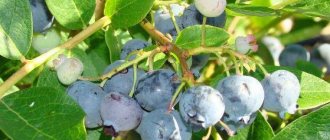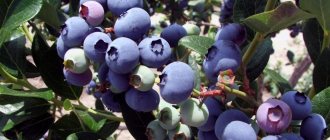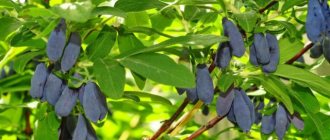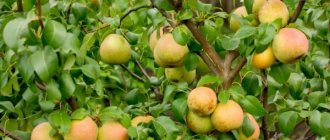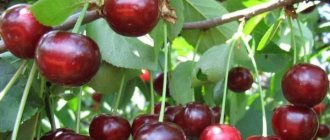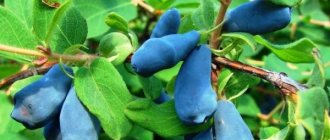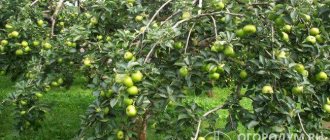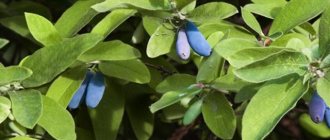History of variety development
The Bonus blueberry variety was bred by American breeders from a university located in Michigan. The basis was taken from a wild blueberry variety, Vaccinium highbush.
The year of official creation of this blueberry variety is 1978. Thanks to the high frost resistance of the Bonus blueberry, this variety is grown in many regions of Russia with harsh winters, however, covering the plants in the same way as rose bushes.
Blueberry Bonus - photo
Blueberry Bonus: characteristics and description of the variety
Bonus blueberry bushes are tall, the diameter of the plant can be up to 1.1-1.2 m, the height of well-leafed spreading shoots is 1.4-1.6 m.
The foliage is elongated, wide at the base and slightly pointed at the tips, shiny, smooth, dark emerald in color, attached to the shoots with short petioles.
The buds from which the leaves grow are located along the entire length of the shoot in the leaf axils. Flower buds grow at the ends of the branches; they are collected in racemose inflorescences, each of which can produce up to 7-10 bell flowers with white petals.
Ripe berries are round in shape, up to 3 cm in diameter, the weight of one Bonus blueberry is 4-5 g.
The color of the dense, rather thin skin is pale blue or dark blue, on which a pale waxy coating is clearly visible. The scar is clearly visible on the side. The pulp is juicy, sweet, greenish in color.
On a note!
If blueberry juice gets on your clothes or skin, removing it is easy and simple.
The harvested crop tolerates transportation well over long distances and can be stored in the refrigerator for a long time. Ripe fruits are eaten fresh, in cooking, and can also be preserved. The berries are also frozen for the winter.
Description
Highbush blueberry Bonus belongs to the Heather family. Its bush can reach a height of 1.3–1.5 m. The plant produces more than a dozen main skeletal shoots, which have numerous lateral branches.
A feature of the variety is its large fruit, due to which it is one of the most productive representatives of the crop. With proper cultivation, one plant can produce from 4 to 7 kg of fruit. Harvest ripening occurs in August, as the variety is mid-late. Due to the dense consistency of the pulp, the berries are suitable for transportation over various distances. It has excellent resistance to sub-zero temperatures (–27.–34°C), but requires stable, moderate soil moisture.
Root system
The underground part of this shrub is well branched and lies in the surface layers of the soil, no deeper than 15–20 cm. Usually it consists of 4-5 thick perennial shoots up to 1 cm in diameter and many small, long and thread-like ones. They are covered with smooth gray-brown bark, the inner wood is green-yellow in color, and is juicy and elastic. When mechanically damaged, a healthy root abundantly secretes clear juice.
Leaves
In the spring, leathery leaves of a dark green color, with slightly jagged edges, appear on the Bonus; in the fall they turn red, which looks very beautiful. This variety can be grown not only for berries: the plant itself will decorate a garden or personal plot.
Productivity of blueberry variety Bonus
Bonus blueberry bushes bloom in mid to late May.
(depending on the climatic conditions of the growing region). Therefore, Bonus blueberries ripen from the last ten days of July to the last ten days of August - depending on the area in which this berry bush is grown.
From each blueberry bush of this variety you can collect 6-8 kg of ripe berries.
Blueberry Bonus produces its first harvest 3 seasons after planting blueberry seedlings in a permanent place.
Harvesting and storage
Blueberry bushes bear fruit from mid-July. Large berries are easily collected and do not fall off on their own. For convenience, use a comb. You can store pure blueberries in the refrigerator, usually for no longer than 2 weeks in glass containers. Fresh blueberries can be used to create fruit purees and desserts.
Frozen fruits retain all useful components. You should not wash blueberries before freezing; their skin will become too tough. When candied or dried, the shelf life is no longer than 1 year.
Diseases and pests
Although Bonus blueberries are highly resistant to a number of dangerous diseases characteristic of other varieties of this berry crop, there are diseases to which this variety’s resistance is quite low.
Blueberry Bonus has low resistance to the following diseases:
- From fungi - to gray rot, mummification of berries, fruit rot, drying of branches;
- From viral ones - to mosaic, filamentous branches, red spotting of foliage.
For prevention purposes, this shrub should be treated with fungicidal preparations several times a season:
- 3 treatments with an interval of 6-8 days before budding. And the processing is carried out the same number of times after harvesting;
- Before the buds open and after leaf fall, the above-ground part of the bush is treated with a solution of Bordeaux mixture.
Blueberry Bonus - video
The following pests can also attack these blueberries:
- aphid;
- caterpillars;
- leaf rollers;
- flower beetle;
- kidney mites.
Effective preparations against pests:
Biofungicide "Glyokladin" Insecticide "Kinmiks" Drug "Fitoverm"
For preventive purposes against pest attacks, insecticidal preparations are used.
To prevent wasps and birds from damaging the ripening fruits, the bush is covered with a special net during ripening.
Patriot
Bushes of this variety thrive in any type of soil, although they prefer heavy, well-moistened soils. They also winter well and are not afraid of late blight and stem cancer.
This variety has an interesting feature: during the ripening process, the berries change color from green to red and only when fully ripe they acquire the usual dark blue color. The fruits ripen early - already in mid-July, they taste pleasant and sweet.
| Maturation | Bush height (m) | Berry diameter (mm) | Productivity (kg per bush) | Peculiarities |
| Mid July | 1,2-1,8 | 17-19 | 4,5-7 | Resistant to late blight |
Advantages of the variety
Gardeners include the obvious advantages of the Bonus blueberry variety:
- large fruit;
- ripe berries can easily be transported over long distances and are stored in a cool place for a long time without losing their taste and presentation;
- the collected fruits contain a large amount of vitamins and other useful substances;
- blueberries reduce blood glucose levels;
- high decorativeness of the shrub;
- this berry crop is hardy and also resistant to a number of diseases;
- excellent taste of ripe blueberries Bonus and delicious aroma;
- this berry bush does not require frequent pruning;
- high resistance to cold (up to -35 degrees Celsius);
- high yield.
Berry varieties:
Black currant Pygmy Cherry Fatezh Cherry Molodezhnaya
Along with the undoubted advantages, the Bonus blueberry variety also has a number of disadvantages:
- the crop ripens unevenly;
- from the moment the characteristic color of the skin appears until the fruits fully ripen, at least 12-14 days pass;
- The bush has an average degree of growth, so there is no increase in yield.
Blugold
The blueberries of this popular variety are light blue, with dense, aromatic pulp.
And the bushes themselves are lush and beautiful, so they will be a wonderful decoration for any garden. However, it is worth considering that spreading is also a disadvantage of this variety of bushes, because they require heavy pruning. Blugold is an early variety. The fruits acquire a rich color at the beginning of summer and ripen by mid-July. From one bush they harvest from 4.5 kg of berries even in not the most productive years.
These blueberries can withstand frosts down to –35°C, so they are suitable for growing in northern regions. The weak point of the variety is that its berries quickly wither and mummify, especially if the summer is hot.
Bluegold berries fall off when overripe, so it is important to harvest on time!
| Maturation | Bush height (m) | Berry diameter (mm) | Productivity (kg per bush) | Peculiarities |
| Mid July | 1,2-1,5 | 16-18 | 4,5-7 | High frost resistance |
Planting blueberries Bonus
Bushes should be planted in a permanent place in the spring, when the return spring frosts have passed.
It is necessary to purchase two-year-old plants - they acclimatize best in a new place after planting and grow faster.
Young bushes are planted in sunny areas where there are no drafts or gusts of north wind. The soil should be loose and fairly fertile - nitrogen-fertilized peat bog and river sand are best suited for this berry crop.
Advice!
Before planting Bonus blueberries, you should check the acidity of the soil. And if it is elevated, you should add lime or dolomite flour to the soil and then regularly check it so that the acidity level does not increase.
Planting holes should be about 1.0 m in diameter and 1.0 m deep
. When planting a large number of Bonus blueberry seedlings, the distance between the holes should be at least 1.5 m, and the direction of the rows should be strictly from north to south.
If groundwater comes close to the surface of the earth, then a layer of drainage material at least 5 cm thick is laid at the bottom of the holes. Broken brick or large expanded clay can be used as such material.
10 liters of water are poured into each hole, wait until it is absorbed, and only then the plants are planted. The seedlings are placed in the center of the holes, the roots are straightened to the diameter of the holes, covered with soil and compacted. Cover the top with a layer of mulch 7-9 cm thick. Rotted sawdust or a mixture of pine needles and peat can be used as a mulching material.
Seven reasons to grow garden blueberries
It's no secret that any fresh berries are a storehouse of vitamins. Blueberries are no exception in this regard. In addition, unlike other plants, it has a positive effect on the entire body as a whole. Regular consumption of fresh blueberries:
- improves vision;
- activates metabolism;
- has a great effect on the immune system;
- reduces the amount of cholesterol in the blood;
- removes waste and toxins;
- strengthens the walls of blood vessels, etc.
Our experts recommend making a healing decoction from the leaves of the plant.
From one bush you can get up to 10 kilograms of berries
This perennial deciduous shrub is native to North America. It grows wild in the eastern United States and Canada. Today, breeders have created many varieties adapted for cultivation in Europe, as well as in Australia and New Zealand.
In the European part, blueberries can grow not only in the northern regions, but also in areas with a warmer climate. You will not regret if you plant this plant on your site.
In the spring, the bushes delight with beautiful flowering, in the summer with berries, and in the fall the leaves acquire a crimson hue. Blueberries can be successfully used in landscape design. It tolerates cutting well and can even be used as a hedge.
Further care for the Bonus blueberry variety
Further care for blueberries Bonus consists of the following agrotechnical measures:
- In compliance with the irrigation regime;
- in fertilizing;
- in removing weeds and loosening the soil;
- in carrying out periodic pruning;
- in the preventive treatment of shrubs against diseases and pest attacks.
Since the soil on which blueberries grow is very light and conducts moisture very well, watering must be taken very seriously. Irregular watering can lead to a decrease in yield, a deterioration in the general condition of the bushes, and sometimes even to their death.
For each bush, 10 liters of water are required once a week.
In hot and dry weather, the number of waterings is increased, and at the same time, in the evenings, the shoots are sprayed with settled warm water.
How to feed blueberries Bonus
In total, fertilizers are applied to blueberries three times per season:
- in spring, before the first young leaves appear;
- when the leaves begin to bloom;
- after harvest.
Blueberry feeding
In the spring, blueberry fertilizers containing a large amount of nitrogen are usually applied to stimulate the growth of the vegetative mass of the bush.
During the period of active emergence of young foliage, apply a fertilizer composed of the following substances:
- 2 tbsp. l. ammonium nitrate;
- 3.5-4 tbsp. l. superphosphate.
After the harvest is harvested, fertilizing consisting of:
- 2.5-3 tbsp. l. potassium sulfate;
- 2.5-3 tbsp. l. superphosphate.
Need to know!
Do not apply manure, compost or bird droppings under blueberry bushes!
Growing
They need to be planted in March, when there are no more frosts. Some advise planting “Bonus” in the fall so that the plant has time to create a powerful root system by summer, but this can lead to freezing of the bushes. Seedlings are used for planting.
Landing location
Under no circumstances choose a place with heavy and dense soil! Blueberries prefer light, acidified soil (the pH should be around 3.5-4.8 to successfully grow blueberries) that can take up a lot of moisture. For example, sand or peat.
Also make sure that the bush gets plenty of sun. Although blueberries naturally grow in thickets, they still love the sun. The place should be well ventilated.
Process
Follow the following algorithm for planting your future blueberries:
- First, measure the acidity of the soil. This should be done six months before planting, so that you have time to carry out the necessary measures to bring the soil to the desired acidity;
- Planting is done from the northernmost hole to the southernmost. If you are planting more than one bush, then maintain a distance of 150-180 centimeters between the holes. If you plant in rows, then create a distance of three meters between them. The hole is dug one meter long and one meter wide;
- Create a drainage approximately five centimeters thick, especially if there is groundwater near the planting site;
- You need to soak the earthen ball of the seedling; to do this, place the pot with it in a container filled with water;
- Fill the holes with water and wait for complete absorption;
- Seedlings are planted in the resulting holes, straightening the roots. Sprinkle acidified soil on top;
- Sprinkle mulch (do not take sawdust under any circumstances, it is better to use pine needles) around the tree trunk area.
Preparing blueberries for winter
In the process of preparing this berry bush for winter, the following activities must be carried out:
- moisture-charging irrigation, during which 25-30 liters of water are added to each bush;
- fertilizing consisting of potassium salt and superphosphate;
- Before the onset of cold weather, the shoots are bent to the ground and covered with a covering material that allows air to pass through - burlap, spruce branches or spunbond.
Important!
You cannot cover blueberry bushes with polyethylene - the bushes may simply die.
Care
Watering
Maintain moderate soil moisture. Approximately a bucket of water should be poured onto each bush. Lack of moisture will lead to slow plant growth and small size of future berries. Check soil acidity regularly. If it starts to fall somewhere, water the plant with acidified water.
Top dressing
In total, “Bonus” is fed three times a year: at the beginning of spring, when the buds open and after harvesting. You should not feed with organic fertilizers unless you want to destroy the roots. First, fertilizing is carried out mainly with nitrogen fertilizers. In the second period, you need to choose a fertilizer so that the nitrogen content is a quarter. At the end of the year, focus on phosphorus fertilizing.
Weeds
To prevent your blueberries from suffocating and losing their share of sun and nutrients, regularly pull out excess plants and fluff up the soil. But be extremely careful with this: the roots of the “Bonus” are located close to the surface and can easily be touched.
Trimming
This procedure should be carried out in the third year, in late autumn after harvest. Excess branches are removed, growth is shortened to a height of 40 to 45 centimeters. Only powerful shoots are left, the rest are disposed of at the beginning of summer.
Disease Prevention
Despite good immunity, it is necessary to prevent diseases so as not to suffer from them later. Choose the fungicide that suits you best and spray blueberries according to the manufacturer's instructions.
Wintering
If you decide to cover the bushes, then first choose the material that is easier for you to find. Never use plastic for blueberries, otherwise the bushes will not survive this winter. The branches are carefully bent down to the ground and carefully covered.
